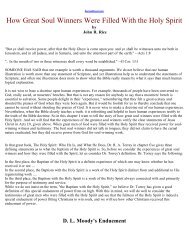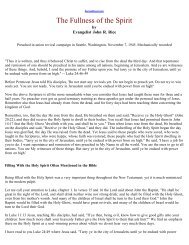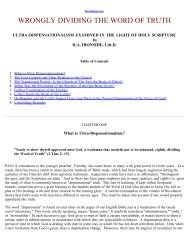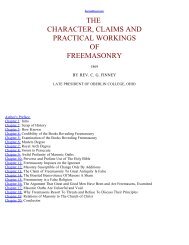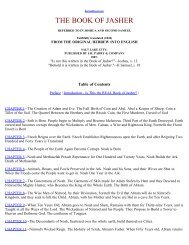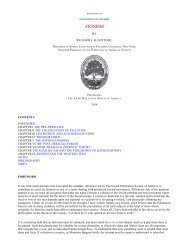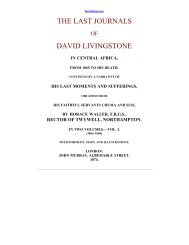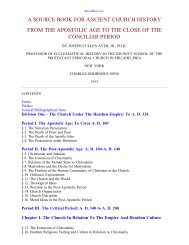Legends of Babylon and Egypt in Relation to Hebrew Tradition.pdf
Legends of Babylon and Egypt in Relation to Hebrew Tradition.pdf
Legends of Babylon and Egypt in Relation to Hebrew Tradition.pdf
Create successful ePaper yourself
Turn your PDF publications into a flip-book with our unique Google optimized e-Paper software.
[6] Eanna was the great temple <strong>of</strong> Erech. In the Second Column <strong>of</strong> the list "the k<strong>in</strong>gdom" is recorded <strong>to</strong> have passed<br />
from Kish <strong>to</strong> Eanna, but the latter name does not occur <strong>in</strong> the summary.<br />
[7] The name Lugalb<strong>and</strong>a is written <strong>in</strong> the lists with <strong>and</strong> without the determ<strong>in</strong>ative for "god".<br />
[8] The name Dumuzi is written <strong>in</strong> the list with the determ<strong>in</strong>ative for "god".<br />
[9] The name Gishbilgames is written <strong>in</strong> the list with the determ<strong>in</strong>ative for "god".<br />
[10] Gap <strong>of</strong> about four, five, or six k<strong>in</strong>gs.<br />
[11] Want<strong>in</strong>g.<br />
At this po<strong>in</strong>t a great gap occurs <strong>in</strong> our pr<strong>in</strong>cipal list. The names <strong>of</strong> some <strong>of</strong> the miss<strong>in</strong>g "k<strong>in</strong>gdoms" may be <strong>in</strong>ferred<br />
from the summaries, but their relative order is uncerta<strong>in</strong>. Of two <strong>of</strong> them we know the duration, a second K<strong>in</strong>gdom <strong>of</strong><br />
Ur conta<strong>in</strong><strong>in</strong>g four k<strong>in</strong>gs <strong>and</strong> last<strong>in</strong>g for a hundred <strong>and</strong> eight years, <strong>and</strong> another k<strong>in</strong>gdom, the name <strong>of</strong> which is not<br />
preserved, consist<strong>in</strong>g <strong>of</strong> only one k<strong>in</strong>g who ruled for seven years. The dynastic succession only aga<strong>in</strong> becomes assured<br />
with the open<strong>in</strong>g <strong>of</strong> the Dynastic chronicle published by Père Scheil <strong>and</strong> recently acquired by the British Museum. It<br />
will be noted that with the K<strong>in</strong>gdom <strong>of</strong> Ur the separate reigns last for decades <strong>and</strong> not hundreds <strong>of</strong> years each, so that<br />
we here seem <strong>to</strong> approach genu<strong>in</strong>e tradition, though the K<strong>in</strong>gdom <strong>of</strong> Awan makes a partial reversion <strong>to</strong> myth so far as<br />
its duration is concerned. The two suggested equations with Antediluvian k<strong>in</strong>gs <strong>of</strong> Berossus both occur <strong>in</strong> the earliest<br />
K<strong>in</strong>gdom <strong>of</strong> Kish <strong>and</strong> lie well with<strong>in</strong> the Sumerian mythical period. The second <strong>of</strong> the rulers concerned, Enmenunna<br />
(Ammenon), is placed <strong>in</strong> Sumerian tradition several thous<strong>and</strong> years before the reputed succession <strong>of</strong> the gods<br />
Lugalb<strong>and</strong>a <strong>and</strong> Tammuz <strong>and</strong> <strong>of</strong> the national hero Gilgamesh <strong>to</strong> the throne <strong>of</strong> Erech. In the first lecture some<br />
remarkable po<strong>in</strong>ts <strong>of</strong> general resemblance have already been po<strong>in</strong>ted out between <strong>Hebrew</strong> <strong>and</strong> Sumerian traditions <strong>of</strong><br />
these early ages <strong>of</strong> the world.



